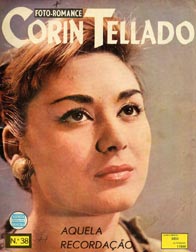RIP Corín Tellado
María del Socorro Tellado López, known as Corín Tellado (April 25 1927, Viavélez, Asturias, Spain – April 11 2009, Gijón, Spain) was a prolific Spanish writer of romantic novels and photonovels that were best-sellers in several Spanish-language countries. She published more than 4,000 novels and sold more than 400-million books which have been translated into several languages. She is listed in the 1994 Guinness World Records as having sold the most books written in Spanish.
digressions:
the romance novel
A romance novel is a literary genre developed in Western culture. Novels in this genre place their primary focus on the relationship and romantic love between two people, and generally has a happy ending.
One of the earliest romance novels was Samuel Richardson’s popular 1740 novel Pamela, or Virtue Rewarded, which was revolutionary on two counts: it focused almost entirely on courtship and did so entirely from the perspective of a female protagonist. In the next century, Jane Austen expanded the genre, and her Pride and Prejudice is often considered the epitome of the genre.
Pride and Prejudice
Pride and Prejudice, first in 1813, is the most famous romance novel. Its opening is one of the most famous lines in English literature—”It is a truth universally acknowledged, that a single man in possession of a good fortune, must be in want of a wife.”
On genre vs. literary
No matter how “literary“, all novels also fall within the bounds of one or more genres. Thus Jane Austen‘s Pride and Prejudice is a romance; Fyodor Dostoevsky‘s Crime and Punishment is a psychological thriller; and James Joyce‘s A Portrait of the Artist as a Young Man is a coming-of-age story. These novels would usually be stocked in the general or possibly the classics section of a bookstore. Indeed, many works now regarded as literary classics were originally written as genre novels. —Sholem Stein
A Young Girl Reading (c.1776) by Fragonard
Literacy: with some exceptions, only a small percentage of the population in many countries was considered literate before the Industrial Revolution. Reading as a means of consuming fiction was at the height of its popularity in the 19th century.
Did women and men have different reading habits? Is there any truth in the claim that women have always read more fiction, women have often been pioneering professional writers and have produced a score of successful authors (Doff, Liala, Delly), yet have been patriarchally excluded from literary histories.
I have many questions regarding the nature of the literary experience. Perhaps I shoul read The Space of Literature?
The Space of Literature, first published in France in 1955, and translated into English in 1982 is central to the development of Blanchot‘s thought. In it he reflects on literature and the unique demand it makes upon our attention. Thus he explores the process of reading as well as the nature of artistic creativity, all the while considering the relation of the literary work to time, to history, and to death. This book consists not so much in the application of a critical method or the demonstration of a theory of literature as in a patiently deliberate meditation upon the literary experience, informed most notably by studies of Mallarmé, Kafka, Rilke, and Hölderlin.


